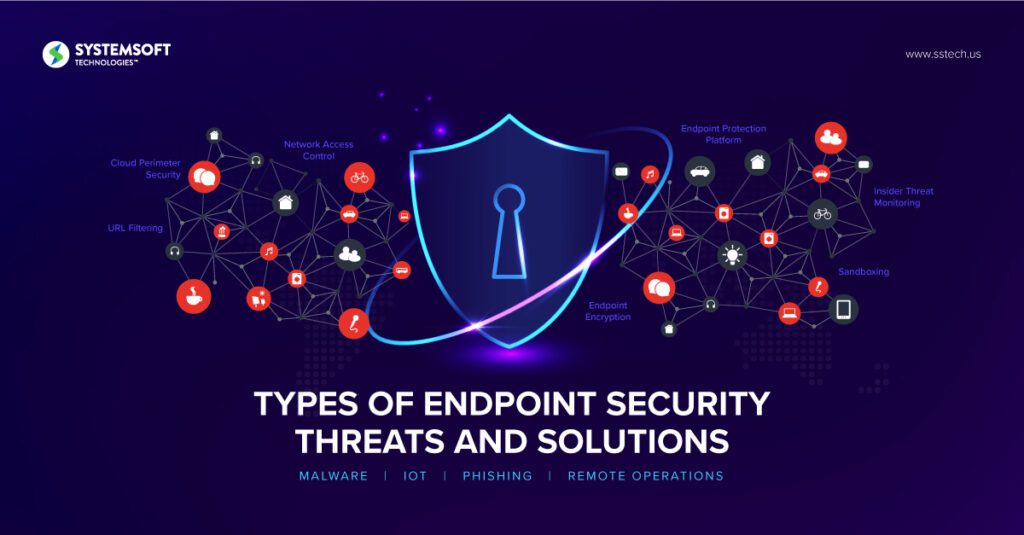With progressing technology, at the same time, vulnerabilities and potential cyber security threats to critical business assets are looming. Endpoint security, or endpoint protection, is an effort to secure any endpoints from these malicious attempts.
Endpoints are anything connected to your organization’s network like computers, laptops, mobile devices and servers. As technology continues to creep into mechanical devices like cameras, watches, exercise equipment, appliances and thermostats, any device connected to the internet becomes an endpoint and another threat vector.
According to a study by the Ponemon Institute, 68% of organizations have experienced one or more endpoint attacks that successfully compromised data and/or their IT infrastructure during the past 12 months.
Because of the growing list of potential endpoints, this creates a growing list of attack vectors for cyber criminals to gain access to your organization’s network. In many cases, this can lead to compromising your sensitive business information and data.
Endpoint Security acts as the front line and perimeter defense for protecting endpoints from potential attacks on your organization.
How Does Endpoint Security Work?
Endpoint security functions by continuously monitoring, detecting and eradicating any suspicious attempts on your organization through a centralized network. Modern-day endpoint security protocols use the cloud to manage the bulk amount of business data.
Moreover, the use of the cloud reduces the excess load on endpoint devices, simultaneously optimizing scalability and speed. Additionally, many vendors are adding intelligence to their endpoint offerings to compare anomalies across all their clients to immediately defend as any attacks begin.
Effective deployment of endpoint security requires a careful preliminary assessment of many factors, and thorough knowledge and information about every access point is mandatory.
Identity and Access Management (IAM) may play a crucial role. IAM provides enterprises command in lending out various controls to specific employees in a managed environment.
After the initial analysis of different endpoints, the next step is the selection of valid cyber security solutions. This includes a broad set of applicable operations for managing and protecting your hardware, software, cloud-based servers and networks. Third-party service providers offer a wide range of solutions for this, depending on the required circumstances.
After that, careful implementation of these solutions forms the basis for successful use of endpoint security. It’s necessary to keep a close check on the deliverability and performance of these applied techniques.
Brief History of Endpoint Security
The concept of endpoint security first appeared during the late 1980s with the emergence of anti-virus software. Then, it would require an IT professional to install the software onto a machine, scanning data to match a signature or known patterns for a virus or malware.
With the evolution of technology, the Internet of Things (IoT) and e-commerce, the potential for cyber-attacks also evolved, ultimately making it difficult for just the use of anti-virus tools and software. Organizations of all sizes and across all industries found it extremely difficult and resource-intensive to deal with malicious attacks.
With the rapid spread of viruses and malware during the early 2000s, the limitations of signature and pattern-based anti-virus software became obvious.
Modern-day endpoint security solutions include a multilayered defense against potential threats through a closed system of integrated networks, which scans and shares information about any possible attacks throughout an ecosystem. This reduces response time to attacks from days or weeks to minutes or hours.
Now, machine learning and artificial intelligence, combined with conventional techniques, are paving the way in making endpoint security highly effective.
4 Major Endpoint Security Threats
Some of the more advanced endpoint security threats these days include the following:
1. Malware. Malware is essentially any malicious code designed to enter private networks in the form of embedded program codes or software, or through devices like USBs. Malware is extremely difficult to find and may remain dormant for months in server.
Malware will attack and extract important business data, which may risk the entire existence of your organization. Demand for ransomware through this breach is the goal of cybercriminals.
2. IoT devices. The Internet of Things is making rampant progress, and its adoption is inevitable. The addition of new connected devices in your business infrastructures can mean an increased attack surface, which can and will be targeted and manipulated by cyber attackers.
Despite all its conveniences, IoT can play into the hands of cyber criminals by increasing your organization’s vulnerabilities.
3. Phishing. Phishing is an attempt to gain user login details through deception or fraud. This is usually initiated through emails linked to fake landing pages designed to assemble information.
They can range from rather obvious attacks to incredibly well-planned and well-executed attacks consisting of copying the targets’ email history, understanding their organizational chart, third-party vendors and partners, and simulating communication styles and conversation patterns when sending money transfer requests.
4. Remote operations. The spread of COVID-19 during the coronavirus pandemic has resulted in many organizations shifting to work-from-home policies and management of healthcare of workers. Remote-based connections pave the way for intrusions, providing a path for exploiting your business systems, then your network and then your entire organization.

Importance of Endpoint Security
Recently, there’s been an unprecedented rise in cyber-attacks and an increase in effective exploits. (The latest is Log4j vulnerability.) Businesses, government institutions and healthcare organizations have been exposed to these risks.
For all organizations, data is the backbone of your organization. Any compromise can cause a complete operational breakdown or downtime, which can both lead to financial and reputational losses.
The technical complexity and thoroughness of cyber-attacks make the victims believe paying a ransom or fulfilling demands of these attacks are the easiest way out. But they’re not. This simply sheds light on the importance of being proactive rather than reactive in managing the security of your organization.
Endpoint security plays a vital role in countering such menaces. Updated methods and software can be used to keep your infrastructure safer from potential attacks.
9 Types of Endpoint Security
Numerous security measures have been discovered to protect endpoint devices from cyber security concerns. Some of the most widely used types of endpoint security include the following:
1. URL filtering. URL filtering is a security feature used to restrict users from accessing unauthorized websites and web applications. It works by comparing URLs that have been entered into a search engine with an allow or deny list, which has been defined by IT admins. It can also be used to improve productivity by keeping users away from unproductive websites.
Like everything, though, it does have a downside. URL filtering can be worked around by using various methods, such as VPNs, proxy, tunneling over SSH or using a TOR browser.
2. Network Access Control (NAC). NAC blocks the entrance of any unauthorized device within the private network of your organization. It ensures only authenticated devices that fully comply with your data policies are part of the network. And progressive organizations need a larger network, which means increased endpoints.
At the same time, a larger network provides an increased opportunity for cybercriminals to break through.
NAC not only prevents such a risk, but also ensures isolation of a particular device in a network in case of a malicious breach. This prevents the spread of the threat. It also limits access to your employees, depending on their role within the enterprise.
Moreover, NAC generates automated reports of any suspicious activity within your organization’s network.
3. Endpoint protection platform (EPP). Endpoint protection works by evaluating every single file within your internal enterprise system. An endpoint security platform carefully assesses every attribute of information stored in data files.
EPP is a centralized and integrated endpoint security protocol. A centralized console helps scale up your business activities by taking care of cyber security issues. Meanwhile, the owner can focus on core business processes.
EPP provides a unified interface increasing overall business efficiency.
4. Sandboxing. Sandboxing is a practice in which you can test a new code or program within an isolated environment. An endpoint operating network is imitated while testing any code carried out.
Sandboxing is believed to be a proactive approach in detecting any potential cyber security concerns. With it, any endpoint device exposed to threats stays out of harm’s way. With the help of software, these devices can be thoroughly examined before running them on your organization’s networks.

5. Secure email gateways. Emails are a fundamental part of your normal day-to-day business activities. Breaking into your business systems through emails has been popular among cyber criminals.
Secure email gateways inspect every email going in and out of your network. It blocks access to any email containing potentially harmful content, including ransomware, malware, spam and phishing.
6. Endpoint encryption. Endpoint encryption is the process of scrambling data. Anyone without the decryption key can’t open it.
Important data files are encoded or encrypted to limit their access within the designated network. Encryption acts as the final barrier safeguarding your information, if a cyber-attack takes place.
There are two types of endpoint encryption. They include:
- Whole drive encryption. This module works by a pre-boot authentication, which typically requires a pin or password to enter the system. Moreover, a trusted platform module (TPM) is often used as a second layer, keeping your drive completely safe and secure and maintaining the integrity of the platform.
- FFRM encryption. This is the encryption of selected database files. It varies from entire drive encryption in that it doesn’t encrypt all data in one go. Instead, it secures individual files, so these files can remain shielded, even when they are out of your private network.
7. Cloud perimeter security. Cloud-based networks, with their endless advantages, are more popular than ever. Small, mid-size and large organizations understand the gains of cloud-based services and are moving or are intending to move toward them.
Meanwhile, on technical grounds, with the adoption of services like cloud, networks keep decentralizing. Hence, they are more exposed to cyber security threats.
Cloud perimeter security safeguards cloud resources. It critically controls traffic accessing the cloud and blocks access in case of any illegitimate attempt.
8. Insider threat monitoring. These concerns can arise from within your organization, if an employee either intentionally or unintentionally makes a mistake sharing privileged information, raising opportunities for cyber criminals.
The management of such threats requires the deployment of the most critical endpoint security measures.
Zero trust access comes in handy dealing with such issues. It incorporates strong authentications and compelling access policies. Moreover, behavioral tools keep a close eye on the activities of employees, alerting management about mischievous activity.
9. Anti-virus solutions. Though an old method, anti-virus software is still effective in dealing with signature-based hacking attempts. It’s the most easily applicable endpoint security protocol and can yield beneficial results detecting malware assembled within your databases.
Benefits of Endpoint Security
The core advantage of endpoint security lies in preventing various cyber-attacks. But it may also provide added advantages in the shape of:
- Cost preservation. As previously mentioned, ransomware attacks can potentially cause drastic losses for your organization. That’s because it can take a lot of time to recover from the severity of these cyber-attacks, keeping your organization’s operations halted or at a slow pace. Proper deployment of endpoint security ensures these losses are never incurred.
- Timesaving. Any intrusion can lead to infrastructure downtime, which can continue for days. Manual backup of your practices can be extremely time-consuming. Endpoint security can prevent valuable time loss.
Conclusion
The type of endpoint security needed is dependent on your business needs. It’s crucial for your business and IT leaders to understand the specifications and layers of endpoint security.
Additionally, a persistent check on the performance of your endpoint security measures is also important.
Cybercrimes are continuously increasing. So, you must ensure endpoint security systems can proactively detect and deter these threats. This, combined with the limitations and new ways of working because of the coronavirus pandemic and an increase in remote workers, underscores the significance of a comprehensive endpoint security solution.
Is your organization currently evaluating your endpoint security environment? System Soft Technologies helps organizations design customized security solutions for their unique business needs.
Contact me for an introductory consultation to get started on your journey to endpoint security.
And stay tuned for another blog article about endpoint security, which will cover a complete overview about how to protect your organization from ransomware through endpoint detection and response. Follow us on LinkedIn.
About the Author: John Nykaza

As a Senior Enterprise Security Architect at System Soft Technologies, John brings more than 20 years of experience delivering enterprise IT security strategies to expand capabilities, reduce global risk exposure and find vulnerabilities. He has expertise in financial technology, cyber security and Big Data solutions to help modernize IT security platforms and drive enterprise security for clients worldwide.

